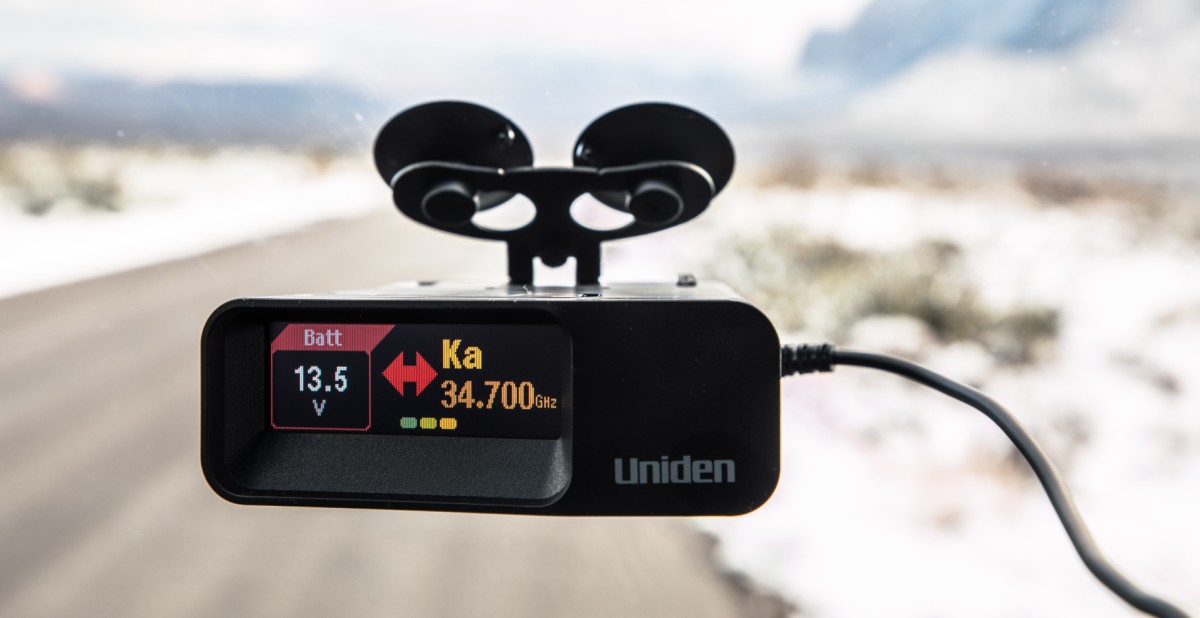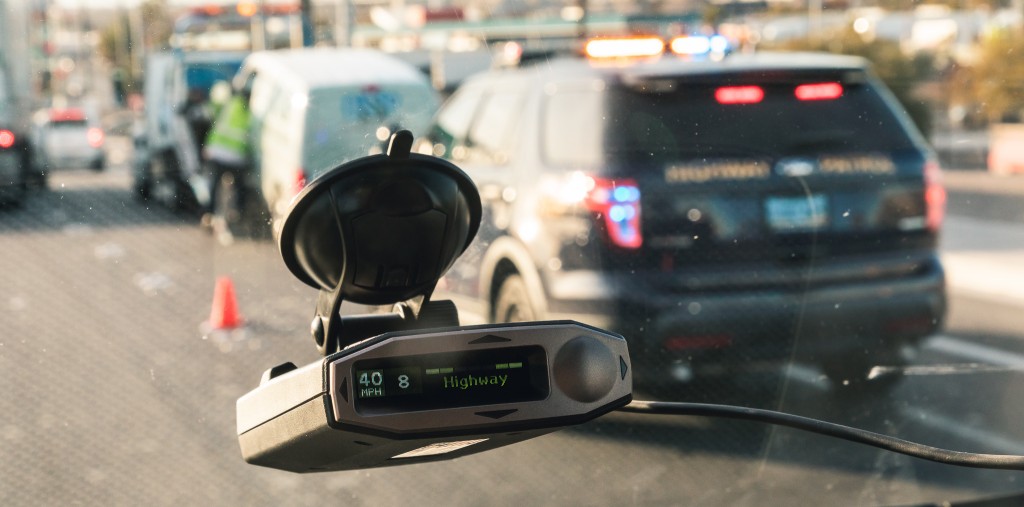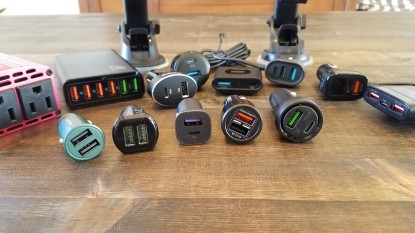Speeding traps have been inconveniencing the automotive community since 1904, when the first ticket was issued for driving a hasty 12 miles per hour. In 1961, one of the first commercial radar detectors, by Radatron, hit the market at a whopping $40. Unfortunately for Radatron, it was rendered useless at high speeds, as the range did not allow drivers enough time to slow down before their speed was recorded. After that, nothing remarkably better hit the market until 1968, when a couple of cops picked on the wrong guy. Dale Smith, an electrical engineer specializing in radars for the U.S. Air Force, was issued a speeding ticket on his way to work. His in-depth knowledge of radars and disdain for law enforcement gave birth to a radar detector far superior to anything else on the market. The Fuzzbuster, aptly named, caught the eye of automobile driving consumers everywhere. It was a simple detector, by today's standards, but with a long-range for the time that would light up in the presence of an active X band.
Upgrades Over the Decades
Needless to say, these devices have come a long way since the '60s. Radars have advanced significantly, and as a result, radar detectors have been forced to make comparable improvements to stay relevant. Over the years, improvements to band detection, signal processing, filtering capabilities, and internet-connected technology have revolutionized radar detection.
Band Detection
Because the frequencies that law enforcement uses have expanded, radar detectors have expanded the frequencies they can recognize. While the S-band was the primary frequency used in 1960, we now use X, K, Ka-band, MultaRadar, and even laser. The best radar detectors can pick up on all five, but not all detectors today can recognize MultaRadar. With more bands came the ability to adjust the sensitivity of band recognition. Offering highway and city modes is a very popular feature that automatically adjusts the sensitivity of certain bands depending on where you are driving. Advanced detectors allow you to adjust the sensitivity of each band individually.
- X-band is an older band that operates between 8.0 and 12.0 GHz. Because it is older, it is not used very often, and in most cases, the sensitivity can be turned down very low or off completely.
- K-band is a somewhat popular frequency used by police radar guns today. It operates between 24.05 and 24.25 GHz. Some users opt to turn down this band's sensitivity as well, but we would not suggest turning it off completely.
- Ka-band is the most popular frequency used by police radar guns today and operates between 33.4 and 36.0 GHz.
- MultaRadar (MRCD/MRCT) is rather new to the U.S. but has been used widely across Canada and Europe for some time now. It does not operate on one frequency. It is a frequency modulated radar or a radar that sends out varied frequencies. Many red light cameras use this radar.
- Laser is often used by higher law enforcement and is emitted from a Lidar gun.
Advanced Signal Processing
Advanced Signal Processing, like Digital Signal Processing (DSP), utilizes a microchip to recognize various bands used by law enforcement and prioritize them. This means that your Ka-band alert will pop up before your X-band alert, even if both are present. Some detectors can show multiple threats too.
Filtering
Filtering has come a very long way over the years. Radars are everywhere these days, so removing the false alert while not compromising the ability to receive true threats is no small feat. In fact, no detector on the market is completely false alarm-free. Detectors nowadays, like the Uniden R7 or the Escort MAX 360, offer stellar filtering capabilities. Advanced levels of customization also allow for the user to adjust their settings to best suit their location.
Internet-Connected Technology
One of the coolest improvements is internet-connected technology. This refers to GPS, Bluetooth connectivity, built-in WiFi, and connection to the cloud. Connecting these devices to the wealth of information that the internet has to offer has completely changed the game. This has paved the way to live updated databases, smartphone apps, and more.
Do You Really Need One?
Before we get into how radar detectors work and what today's market has to offer, it's important to take a moment to figure out whether or not you will benefit from having one of these devices in your vehicle. A few things you will want to consider are the legality of radar detectors in your area, your driving style, and whether or not you're willing to put the effort into understanding what your device has to offer.
Are Radar Detectors Legal Where You Live?
In the '60s, after the first few radar detectors hit the market, law enforcement was furious, and these nifty tools were outlawed in select states. Since then, most states in the U.S. have repealed these laws for passenger vehicles. Radar detectors are prohibited, however, in most commercial vehicles.
In the U.S., radar detectors are prohibited in the following places:
District of Columbia
Virginia
In Canada, radar detectors are prohibited in the following places:
Manitoba
New Brunswick
Northwestern Territories
Nunavut
Ontario
Prince Edward Island
Quebec
Yukon
How Is Your Driving?
Having a device that alerts you to potential speed traps is an undeniably useful tool for the chronic speeder. That being said, if you do not tend to push the pedal to the metal, then do you need one? You don't have to be a chronic speeder to benefit from one of these nifty devices, but it's important to weigh the ramifications of getting a speeding ticket against the cost of a detector. Radar detectors range from $50 to well over $600. While the cost of a speeding ticket varies greatly based on the location and severity of the offense, the average ticket is roughly $150. Take a moment to decide whether buying even a mid-range detector will save you money in the future. While you are calculating, don't forget to factor in the possibility of your insurance increasing if points are removed from your license.
Are You Willing to Put in the Work?
Lastly, the more advanced models, which are more costly, allow for optimal customization. This is wonderful, as it cuts down on false alerts and increases overall accuracy. That being said, if you know nothing about radar detectors, you'll need to spend some time getting to know yours. Finding the right settings for your area is vital to the level of accuracy your detector will operate at.
How Do Radar Detectors Work?
To understand how a radar detector works, you must first understand how a radar device works. When law enforcement uses radar to give out speed tickets, they are either using a dash radar or a radar gun. A radio wave is released from the device at the click of a button. This wave is sent out at the speed of light, hits its target, and then returns to the radar device. Because the target, or vehicle, is moving towards the device, the wave that comes back will return at a higher frequency. If your speed is being recorded from behind, the wave that comes back will return at a lower frequency. The radar gun then compares the transmitted frequency against the reflected frequency to calculate the speed of the targeted vehicle.
When radar guns emit their radio waves, they cast a large net. This makes it easy for a radar detector to pick up a radar device before it is being pointed directly at them. Any radio waves that do not hit an obstacle continue until they are absorbed or reflected. If the device is not emitting waves, then there is nothing to be detected, and your device will not alert you of law enforcement. They are called radar detectors, not cop detectors, for a reason.
Some advanced radar detectors come equipped with signal jammers. This means that the device sends back a scrambled signal that the radar gun can no longer calculate and turn into a tangible speed. Radar jammers are generally illegal across the board, but laser jammers are not. Lidar guns are usually used by higher status law enforcement like a State Trooper. The laser gun shoots a beam directly at the target. It does not emit a large wave like the radar guns do.
Because radars are used so widely in society these days, it can be difficult for a detector to decipher between a true threat and a benign one. An alert caused by a benign threat is called a false alert. This means that something set the device off, but the source is not law enforcement hungrily waiting around the corner to give you a ticket. False alerts can be triggered by automatic doors at your local grocery store, In-Vehicle Technology (IVT) like Blind Spot Monitoring (BSM) on neighboring cars, or Traffic Sensor Radars. Advanced detectors offer features that help filter out these false alerts; however, there is no perfect radar detector when it comes to accuracy, so it's important to get to know your device so you can interpret each alert appropriately.
How to Choose a Radar Detector
If you have made it this far, then you're probably convinced that you could benefit from a radar detector. Now it's time to decide which one you want.
What Is Your Budget?
The first thing you should do to narrow down your search is to decide how much are you are willing to spend. Can you afford a radar detector? Or maybe you the kind of person who can't afford not to have one. Generally speaking, you get what you pay for, but that does not mean that you need to go out and buy the most expensive option. Range, accuracy, and ease of use are very important, but features are really what set one device apart from the rest. That being said, you may find that you don't care for some of the features, so there is no need to waste your money on something that you're not going to use.
Available Features
Now that you have checked your bank account and crunched some numbers, it's time to find out what your options are. The features available today are far superior to what the Fuzzbuster had to offer back in the '60s. From internet-connected technology to filtering capabilities, each set of features offers a unique driving experience.
Internet-Connected Technology
Internet-connected technology is a blanket term that refers to GPS, WiFi, Bluetooth, and Cloud connectivity. Not all detectors offer this, but most modern models offer some kind of internet or cloud connectivity. It is rare to find a device with all three, but if you do, it will cost you a pretty penny. If you are the kind of person who prefers to have an app on your smartphone, you may want to explore the Escort MAX 360 or Escort MAX 360c. If you prefer not to rely on two devices and would like a detector with everything it needs within it, try the Uniden R7 or Uniden R3.
Accuracy Features
Accuracy is vital to a quality detector, and many features help improve it. If your priorities align more with your bank account and less with the mitigation of false alerts, then the very simple and very inexpensive Uniden DFR1 is the pick for you. If you don't mind a few false alerts but are willing to spend a little more to ensure that your device isn't chatting up a storm on the highway, you will want to take a look at our mid-priced models. The Uniden DFR7 or slightly higher priced Uniden R3 offer more accuracy improving features like traffic sensor filtering and band sensitivity adjustments. Here are some accuracy improving features to think about:
IVT FilteringMany modern cars today come equipped with radar to help prevent collisions while driving or parking. IVT filtering helps fight against false alerts triggered by in-vehicle technology like Blind-Spot Monitoring or backup cameras.
TSF FilteringMany highways have traffic sensor monitoring devices that often trigger the K-band alert. TSF filtering helps locate these devices and mute their alerts.
K and Ka Narrow FiltersEach band operates within a frequency range. Those ranges can be rather wide, so narrow filter features will only allow your device to alert you when the frequencies being received are the ones that coincide with radar guns used in the U.S.
Band Sensitivity Control
Since different radar devices are used in different places, many advanced detectors allow you to adjust the sensitivity of each band accordingly. Some devices are not as a la cart, but they still offer adjustment to sensitivity through various presets like highway and city modes.
GPS Location Lockouts
Because false alerts can be triggered by non-threatening stationary radars, like the ones found on automatic doors, advanced detectors that have GPS capabilities will allow you to lock out certain signals in a specific location. A simple double click of the mute button will ensure that you won't be burdened with future false alerts every time you go to the grocery store. This can be done manually or in some cases, like with the Escort MAX 360c, will be done automatically.
User Marks
On the flip side, if there is an area that you often spot speed traps and you want some added insurance, you can mark a location to be reminded of it every time you get close.
Range Features
The range is rather straightforward and doesn't require many bells and whistles; however, there are a couple of things to pay attention to here.
Front and Back AntennaHaving both a front and a back antenna allows for 360-degree detection. Law enforcement can record your speed from in front of or behind you, so this is important. Many devices also have arrows that indicate where the threat is coming from.
Range Length
Long-range and mid-range detectors are the only ones you'll find on the market. Nobody advertises their device as low-range. Investing in a long-range detector will guarantee that you are given enough time to slow down before your speed is collected by law enforcement. Uniden leads the industry in this department.
Ease of Use Features
If a detector is overcomplicated, it could cause confusion while driving, which is dangerous. Features like directional arrows are obvious ease-of-use improvers, but many more work behind the scenes.
Level of CustomizationWhile the level of customization is not a feature in and of itself, it does apply to most of the features. Being able to turn on and off every feature, change each alert sound, and even adjust your screen's brightness makes operating and understanding your device much easier.
Directional Arrows
Some devices have arrows that indicate the direction of the threat. This is a very helpful feature that most of the more advanced models incorporate into their design.
Modes
Some devices offer various modes based on your level of familiarity with radar detectors or the terrain you are driving on. These include Novice, Expert, Highway, and City modes.
Related: How We Tested Radar Detectors



















